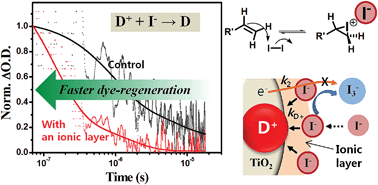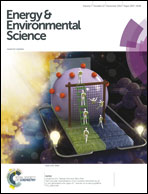Fast cascade neutralization of an oxidized sensitizer by an in situ-generated ionic layer of I− species on a nanocrystalline TiO2 electrode†
Abstract
We report a novel way to accelerate the rate of oxidized sensitizer neutralization on nanocrystalline TiO2 electrode surfaces using a novel coadsorbent, 3,4,5-tris-butenyloxy benzoic acid (TD), having three terminal double bonds. 1H NMR and contact angle measurements revealed that the terminal double bonds reacted with I2 to form an in situ-generated ionic layer of I− species. Transient absorption spectroscopy (TAS) and electrochemical impedance spectroscopy (EIS) studies demonstrated that I− species neighbouring the cationic dye molecules (D+) accelerate the neutralization (or regeneration) rate (kD+), as well as decrease the recombination reactions of photoinduced electrons with D+ (k1) and I3− (k2). Dye-sensitized solar cells treated with TD exhibit a power conversion efficiency of 10.2%, which is 22% higher due to the simultaneous improvements in JSC and VOC, even at 15% low dye loading levels, compared to the values obtained from a conventional device.


 Please wait while we load your content...
Please wait while we load your content...